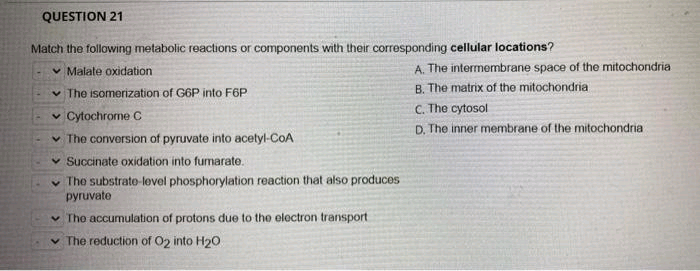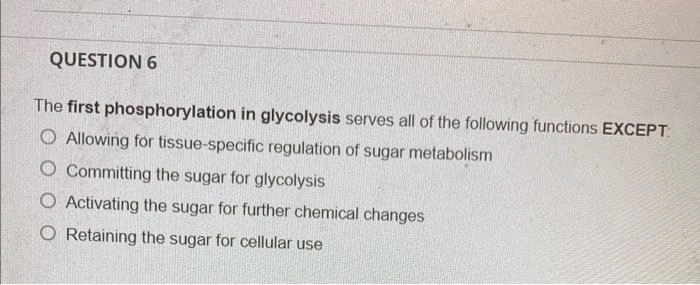QUESTION 21 Match the following metabolic reactions or components with their corresponding cellular locations? Malate oxidation The isomerization of G6P into F6P ✓ Cytochrome C The conversion of pyruvate into acetyl-CoA Succinate oxidation into fumarate. The substrate-level phosphorylation reaction that also produces pyruvate The accumulation of protons due to the electron transport The reduction of O2 into H₂O A. The intermembrane space of the mitochondria B. The matrix of the mitochondria C. The cytosol D. The inner membrane of the mitochondria
QUESTION 21 Match the following metabolic reactions or components with their corresponding cellular locations? Malate oxidation The isomerization of G6P into F6P ✓ Cytochrome C The conversion of pyruvate into acetyl-CoA Succinate oxidation into fumarate. The substrate-level phosphorylation reaction that also produces pyruvate The accumulation of protons due to the electron transport The reduction of O2 into H₂O A. The intermembrane space of the mitochondria B. The matrix of the mitochondria C. The cytosol D. The inner membrane of the mitochondria
Biochemistry
9th Edition
ISBN:9781319114671
Author:Lubert Stryer, Jeremy M. Berg, John L. Tymoczko, Gregory J. Gatto Jr.
Publisher:Lubert Stryer, Jeremy M. Berg, John L. Tymoczko, Gregory J. Gatto Jr.
Chapter1: Biochemistry: An Evolving Science
Section: Chapter Questions
Problem 1P
Related questions
Question

Transcribed Image Text:QUESTION 21
Match the following metabolic reactions or components with their corresponding cellular locations?
✓Malate oxidation
✓ The isomerization of G6P into F6P
✓ Cytochrome C
✓ The conversion of pyruvate into acetyl-CoA
Succinate oxidation into fumarate.
The substrate-level phosphorylation reaction that also produces
pyruvate
✓ The accumulation of protons due to the electron transport
✓ The reduction of O2 into H₂0
A. The intermembrane space of the mitochondria
B. The matrix of the mitochondria
C. The cytosol
D. The inner membrane of the mitochondria

Transcribed Image Text:QUESTION 6
The first phosphorylation in glycolysis serves all of the following functions EXCEPT:
O Allowing for tissue-specific regulation of sugar metabolism
O Committing the sugar for glycolysis
O Activating the sugar for further chemical changes
O Retaining the sugar for cellular use
Expert Solution
This question has been solved!
Explore an expertly crafted, step-by-step solution for a thorough understanding of key concepts.
This is a popular solution!
Trending now
This is a popular solution!
Step by step
Solved in 9 steps

Recommended textbooks for you

Biochemistry
Biochemistry
ISBN:
9781319114671
Author:
Lubert Stryer, Jeremy M. Berg, John L. Tymoczko, Gregory J. Gatto Jr.
Publisher:
W. H. Freeman

Lehninger Principles of Biochemistry
Biochemistry
ISBN:
9781464126116
Author:
David L. Nelson, Michael M. Cox
Publisher:
W. H. Freeman

Fundamentals of Biochemistry: Life at the Molecul…
Biochemistry
ISBN:
9781118918401
Author:
Donald Voet, Judith G. Voet, Charlotte W. Pratt
Publisher:
WILEY

Biochemistry
Biochemistry
ISBN:
9781319114671
Author:
Lubert Stryer, Jeremy M. Berg, John L. Tymoczko, Gregory J. Gatto Jr.
Publisher:
W. H. Freeman

Lehninger Principles of Biochemistry
Biochemistry
ISBN:
9781464126116
Author:
David L. Nelson, Michael M. Cox
Publisher:
W. H. Freeman

Fundamentals of Biochemistry: Life at the Molecul…
Biochemistry
ISBN:
9781118918401
Author:
Donald Voet, Judith G. Voet, Charlotte W. Pratt
Publisher:
WILEY

Biochemistry
Biochemistry
ISBN:
9781305961135
Author:
Mary K. Campbell, Shawn O. Farrell, Owen M. McDougal
Publisher:
Cengage Learning

Biochemistry
Biochemistry
ISBN:
9781305577206
Author:
Reginald H. Garrett, Charles M. Grisham
Publisher:
Cengage Learning

Fundamentals of General, Organic, and Biological …
Biochemistry
ISBN:
9780134015187
Author:
John E. McMurry, David S. Ballantine, Carl A. Hoeger, Virginia E. Peterson
Publisher:
PEARSON